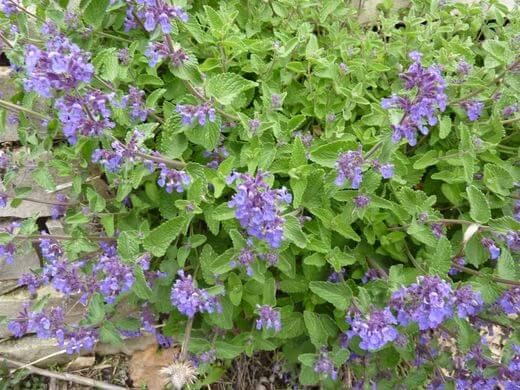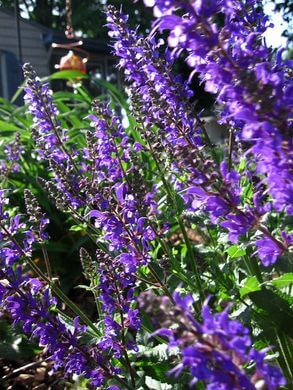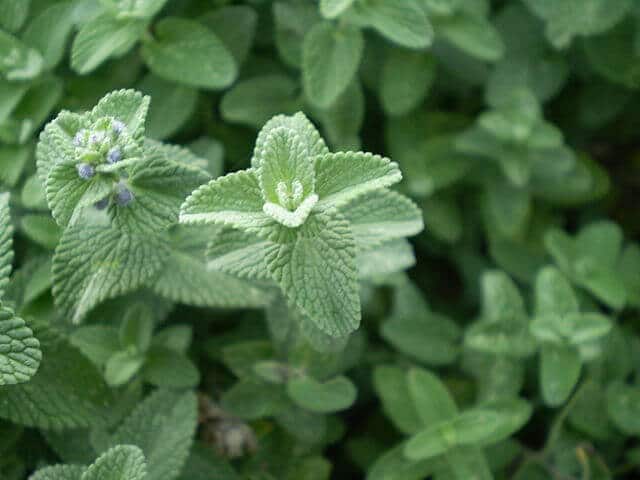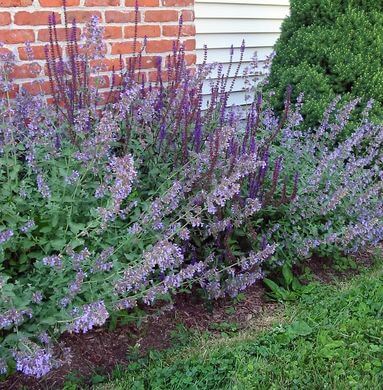Editor’s note: This article was originally published in May 2019. Updated April 2022.
As its name implies, the catmint plant can be irresistible for cats. This perennial herb is known to induce a mild euphoria in animals, especially cats. Catmint is part of the mint family and there are several species that are native to different countries and continents. A number of plants within the Nepeta genus are known as catnip or catmint. These include Nepeta grandiflora (native to Caucasus), Nepeta sibirica (native to Siberia), and Nepeta racemosa (native to the Caucasus and Turkey).
The Nepeta grandiflora catmint species is the most widely known as it is frequently grown as an ornamental garden plant. It can grow up to 30” tall, with fragrant spires of dark grey-green leaves and lavender-blue flowers which bloom in the summer. Nepeta grandiflora is related to true catnip (Nepeta cataria), but the leaves are lusher and the flowers are purple instead of white/pink.

Edibility and culinary use of Catmint
Despite being known for its effects on felines, cats aren’t the only ones who can enjoy catmint. This plant is edible and it even has some medicinal benefits for us too. The leaves and flowers can be steeped to make a soothing herbal tea with a mild minty taste and a sweet fragrance. Alternatively, you can also eat young cat mints leaves. They have a lovely minty flavor and a mild fragrance, making them a great aromatic addition to salads. Meanwhile, older leaves can be used as a potherb in cooked dishes.
Health benefits of Catmint
Aside from relieving tension and improving sleep quality, this herb also offers other health benefits. Much like other herbal teas, catmint herbal tea can aid digestive problems such as upset stomachs, excessive gas, diarrhea, and nausea. It’s also good for respiratory problems such as cold, cough, and chest congestion. Catmint could also help to relieve stomach pain and menstrual cramps too.

Catmint also has a diuretic effect, this induces sweating and increases urination frequency. As a result, this herb is often used to treat fever and water retention. Lastly, it has anti-inflammatory effects, so it can also be used to treat arthritis, hemorrhoids, and bug bites.
Catmint contains a compound called nepetalactone, which is the compound that makes this herb so irresistible to cats. Among other benefits, nepetalactone has a calming and relaxing effect. So, this herbal tea really helps in relieving stress and reducing anxiety. It even has a mild sedative effect which can relieve insomnia and allow you to sleep better.

(Photo by: KitAy/Flickr)
Catmint cultivation
Catmint is a wonderful addition to any garden, regardless of whether you wish to make your garden feline-friendly or not. As we’ve covered earlier, catmint is certainly a useful herb to have around. The eye-catching flowers can also attract butterflies that will help your garden thrive. At the same time, it will protect your garden from harmful insects like ants and flea beetles as well as other pests like rats and mice.
Ideally, you should plant catmint in a sunny location, but it can also tolerate partial shade. As for the soil, catnip loves sandy soil and clay soil that’s somewhat moist and well-drained. This hardy plant is drought-resistant, so you don’t have to water them too often. You also don’t need to bother with fertilizer too much, just once or twice a year will do. Catmint can thrive in poor soil. In fact, rich soil may sometimes cause the plant to split in the middle.

Growing catmint from seed
Start the seeds indoors 6 to 8 weeks before the last frost date. Make sure to keep the seeds warm, moist, and fertilized. After they are well-established, they can be transplanted into your garden after the last danger of frost has passed. Keep them 12” apart from each other to avoid overcrowding. They should be able to start blooming in their first summer if you plant them early enough.

Cautions
Catmint should be avoided by pregnant women and those with pelvic inflammatory disease because it could induce menstruation. It’s also advisable to stop or limit catmint consumption during menstruation as it may make periods heavier. Lastly, catmint has mild sedative effects, so avoid consumption before driving and two weeks before any scheduled surgery.
Conclusion
Whether you have a pet cat or not, having a catmint plant around will still benefit you immensely. Aside from being a lovely ornamental plant, it can also help your garden thrive by attracting butterflies and repelling pests. Additionally, catmint has had an extensive history of being a household herbal remedy. Its delicious minty taste makes it great to use in cooking and as an herbal medicine.
Featured Image: Catmint spires photo by DoF CC-BY-X on Wikimedia Commons
---------------
Writen by Cornelia Tjandra
Cornelia is a freelance writer with a passion for bringing words to life and sharing useful information with the world. Her educational background in natural science and social issues has given her a broad base to approach various topics with ease. Learn more about her writing services on Upwork.com or contact her directly by email at cornelia.tjandra@gmail.com
Many of our readers find that subscribing to Eat The Planet is the best way to make sure they don't miss any of our valuable information about wild edibles.
See our privacy policy for more information about ads on this site







10 Responses
Hi! Thanks for the article. But i have one question.. How can it help against menstrual pain but is at the same time not advised to take during menstruation.
Additionally, I am a bit confused with the fact that catmint would be loved by cats, when it is actually catnip they love.
I can answer the catnip part
It said “Catmint contains a compound called nepetalactone, which is the compound that makes this herb so irresistible to cats.”
Cats love both catnip and catmint
Hope I could help 🙂
I caught that, too!
it appears you misread .. it can be used for menstruation,, but do not use when pregnant as it could cause you to go into menstruation and miscarry.
Will I start having stray cats in my yard if I decide to plant cat mint?
I have 3 large catmint plants in my yard and the neighborhood cats couldn’t care less about them.
Catmint is also used for Mastitis (infection in the breast when nursing). Steep a large handful of leaves in a cup of water in a small kettle until the water turns green. Take the leaves out and wrap them in a bit of cheesecloth and apply to infected area. The catmint will draw the infection out and will reduce the swelling. Little girlfriend had a spider bite that was the size of a quarter, red and swollen, and couldn’t get her boots on for the beginning of fair the next morning. Made the catmint poultice, applied to spider bite on ankle, put her sock on, sent her to bed. She woke up and swelling, pain, and itching were all gone. She went to fair with no worries. <3
I’m wondering if it would be a good poutine or salve for huge bug bites. I got at least dime-sized bumps on my arms and legs from the garden two days ago. They itch like mad and are still swollen.
it appears you misread .. it can be used for menstruation,, but do not use when pregnant as it could cause you to go into menstruation and miscarry.
Can it be used to make mint jelly?